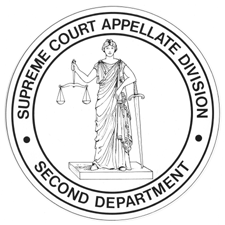

The Appellate Division is New York State's intermediate level appellate court. It hears appeals from trial courts and has jurisdiction to hear certain original proceedings commenced in or transferred to it as provided by law. In determining appeals it has power to review issues of law, fact, and discretion arising in civil and criminal cases. Appeals from the Appellate Division are taken to the Court of Appeals, the State's highest court. The greater part of all appellate review in New York State is provided by the Appellate Division.
The State of New York is divided into four Judicial Departments. Each Department of the Appellate Division exercises its jurisdiction in a separate geographic region. The Second Department includes just over 8% of New York's land area and contains slightly more than one-half of the State's population. It is comprised of the 10 downstate counties of Richmond, Kings, Queens, Nassau, Suffolk, Westchester, Dutchess, Orange, Rockland, and Putnam. The court hears civil appeals from the Supreme Court, Surrogate's Court, Family Court, and Court of Claims and criminal appeals from the Supreme Court and County Court in those 10 counties. Demographically it ranges from highly urban in the New York City counties of Kings (Brooklyn), Queens, and parts  of Richmond (Staten Island), suburban in Nassau, Westchester, and parts of Richmond, Suffolk, and Rockland, and relatively rural in Orange, Dutchess, Putnam, and parts of Suffolk and Rockland. The courthouse of the Appellate Division, Second Department, is located in Kings County in the Brooklyn Heights Historic District.
of Richmond (Staten Island), suburban in Nassau, Westchester, and parts of Richmond, Suffolk, and Rockland, and relatively rural in Orange, Dutchess, Putnam, and parts of Suffolk and Rockland. The courthouse of the Appellate Division, Second Department, is located in Kings County in the Brooklyn Heights Historic District.
The Supreme Court, of which the Appellate Division is a part, is New York State's principal trial court, with a branch in each of the State's 62 counties. The Justices of the Supreme Court are elected to 14-year terms by the voters of their respective judicial districts; there are 13 such districts in New York State. All Supreme Court Justices have a mandatory retirement age of 70.
Retired Justices may be certified for additional service on the Supreme Court or the Appellate Division for two-year periods. No Justice may serve past the age of 76. The Justices of the Appellate Division are designated by the Governor from among the Justices of the Supreme Court. The Governor also designates the Presiding Justice in each Department. The State Constitution fixes the number of Justices on the bench of the Second Department at seven, but in the event that the court certifies that additional Justices are necessary for the speedy disposition of the business before the court, the Governor may designate additional Justices to serve as long as the need exists. At full complement, twenty-two Justices sit on the Second Department, seven on the constitutional bench and fifteen as Additional Justices.
A History of the Court
The Origins of Appellate Review in New YorkThe forerunner of today's Supreme Court, the Supreme Court of Judicature was created in 1691. Its Justices sat as trial judges in circuit courts and sat together several times a year to make rulings on points of law raised in Supreme Court pleadings or in circuit court trials and in an appellate role to review and correct errors made by judges of inferior courts. During the colonial era appeals from the Supreme Court of Judicature lay to the Royal Governor and his council, sitting as a court for the correction of errors and appeals. Under New York's first Constitution, adopted in 1777 during the Revolutionary War, the jurisdiction of the Supreme Court of Judicature was continued largely unchanged and final appellate review was vested in a new tribunal called the Court for the Trial of Impeachments and the Correction of Errors.
 In 1846 the State's court system was extensively reorganized. The former Court of Chancery was abolished and the Supreme Court of Judicature was reorganized and replaced by a new Supreme Court that became the State's highest court of original, unlimited jurisdiction in both law and equity. The Court for the Trial of Impeachments and the Correction of Errors was replaced by the Court of Appeals. Appeals from the Trial Terms of the Supreme Court and from lower civil courts were to be decided in a General Term of the Supreme Court in each of eight judicial districts. A designated Presiding Justice and at least two of the three additional Supreme Court Justices in each judicial district constituted the General Term.
In 1846 the State's court system was extensively reorganized. The former Court of Chancery was abolished and the Supreme Court of Judicature was reorganized and replaced by a new Supreme Court that became the State's highest court of original, unlimited jurisdiction in both law and equity. The Court for the Trial of Impeachments and the Correction of Errors was replaced by the Court of Appeals. Appeals from the Trial Terms of the Supreme Court and from lower civil courts were to be decided in a General Term of the Supreme Court in each of eight judicial districts. A designated Presiding Justice and at least two of the three additional Supreme Court Justices in each judicial district constituted the General Term.
A new judiciary article of the Constitution was adopted in 1869 which organized the State into four judicial departments and authorized the creation of not more than four General Terms with a Presiding Justice and not more than three Associate Justices in each department to be appointed by the Governor and to sit in panels of three. In 1882 the State Constitution was amended to create a fifth department. Justices of the Supreme Court who were appointed to serve on the bench of the General Term during this period continued to serve as trial judges and only exercised their appellate powers while sitting in the General Term when it was in session.
In 1890 a commission studied the State judiciary and made numerous recommendations for change. Eventually these recommendations were referred to a constitutional convention held in 1894.
It was at the Constitutional Convention of 1894 that the present Appellate Division of the Supreme Court was created. The intermediate appellate court of the State was renamed the Appellate Division rather than the General Term. The State was divided into four Judicial Departments and the tribunal within each Department was given the independence to control the place of its sessions and to appoint its clerk. The Governor was given the power to designate Justices of the Appellate Division for fixed five-year terms from all the Justices elected to the Supreme Court. Appellate Division Justices were relieved of all other duties so that there could be the fullest opportunity for consultation and deliberation. It was intended that court sit in panels of five Justices, four would constitute a quorum, and the concurrence of three would be necessary for a decision.
The reforms of the Constitution of 1894 strengthened the intermediate tier of appellate review and made a clearer demarcation between the functions of the Court of Appeals and the Appellate Division. The principal purpose of the Court of Appeals was "reaffirmed as declaring and settling the law rather than considering the justice of particular cases on their facts." At the same time, it was intended that the newly created Appellate Division would provide the "sole appellate review for the vast majority of cases, so that the Court of Appeals could devote its attention to articulating general principles and reconciling conflicts among the lower courts." It was hoped that the strengthening of the intermediate appellate tier would lead to a higher quality of appellate review and that, as a result, most litigants would be satisfied with the quality of appellate justice received in the Appellate Division and would not seek further review in the Court of Appeals.
It was hoped that the strengthening of the intermediate appellate tier would lead to a higher quality of appellate review and that, as a result, most litigants would be satisfied with the quality of appellate justice received in the Appellate Division and would not seek further review in the Court of Appeals.
In 1899 the Constitution was amended to provide that in the event that a Department of the Appellate Division certified that one or more additional Justices were necessary for the speedy disposition of the business before it, the Governor was empowered to temporarily designate additional Justices to serve in that Department. The present constitutional provision was adopted in 1961 and it continues the basic scheme of the authors of the constitutional provision of 1894.
The Constitution of 1894 provided that the Appellate Division was to succeed to the jurisdiction of the former General Terms and was to have such additional jurisdiction as might be conferred by the Legislature. Thus the source of the jurisdiction of the Appellate Division has historically been found both in the Constitution and in statutory law. The present constitutional provision provides that the Departments of the Appellate Division shall have all the jurisdiction possessed by them on its effective date and such other jurisdiction as may be prescribed by law, with the proviso that the right to appeal to the Appellate Division from intermediate orders or judgments may be limited or conditioned by law.
 In civil cases originating in the Supreme Court, Surrogate's Court, and Court of Claims, most orders, judgments, and decrees are appealable to the Appellate Division as of right, as are dispositional orders of the Family Court. Appeals from intermediate orders in CPLR article 78 proceedings and in most proceedings commenced in the Family Court are appealable only by permission. In criminal actions, appeals to the Appellate Division are generally authorized as of right by the defendant from a judgment or a sentence. Pre-judgment orders are not appealable by a criminal defendant, but certain post-judgment orders are appealable by the defendant only by permission. The People may appeal as of right from certain pre- and post-judgment orders and sentences. Appeals as of right are taken by filing a notice of appeal in the office of the clerk of the court in which the order or judgment appealed from was made and appeals by permission are taken by making a motion for leave to appeal and obtaining an order granting such permission.
In civil cases originating in the Supreme Court, Surrogate's Court, and Court of Claims, most orders, judgments, and decrees are appealable to the Appellate Division as of right, as are dispositional orders of the Family Court. Appeals from intermediate orders in CPLR article 78 proceedings and in most proceedings commenced in the Family Court are appealable only by permission. In criminal actions, appeals to the Appellate Division are generally authorized as of right by the defendant from a judgment or a sentence. Pre-judgment orders are not appealable by a criminal defendant, but certain post-judgment orders are appealable by the defendant only by permission. The People may appeal as of right from certain pre- and post-judgment orders and sentences. Appeals as of right are taken by filing a notice of appeal in the office of the clerk of the court in which the order or judgment appealed from was made and appeals by permission are taken by making a motion for leave to appeal and obtaining an order granting such permission.
In addition to its appellate jurisdiction, the Appellate Division is also required to entertain certain original proceedings. These include, among others, special proceedings against certain judicial officers, transferred CPLR article 78 proceedings to review determinations of administrative bodies or officers made after a hearing at which evidence was taken, proceedings to review certain determinations of the New York State Division of Human Rights, habeas corpus proceedings, and proceedings regarding the professional discipline of attorneys.
In the process of deciding an appeal, appellate courts must review the claims of the appellant that the court from which the appeal was taken made certain errors affecting the order or judgment on appeal. Unlike the Court of Appeals, which, with limited exceptions, has only the power to review errors of law, the Appellate Division has broad power to review questions of law, findings of fact, and exercises of discretion.
Thus the Appellate Division has both appellate and original jurisdiction over a wide variety of matters. It has broad powers to review errors of law, findings of fact, and exercises of discretion, and somewhat more circumscribed powers of review in original special proceedings. This statutory scheme is in general conformity with the intent of the framers of the Constitution of 1894 that the principal purpose of the Appellate Division was to be the promotion of substantial justice by the correction of errors and the screening of cases for the Court of Appeals.
The broad grant of jurisdiction and powers of review to the Appellate Division, the State's population growth, and the increasingly litigious nature of society have resulted in an enormous expansion of the number of appeals, special proceedings, and associated motions presented to the Appellate Division, Second Department, for determination. When the boundaries of the Second, Third, and Fourth Departments were drawn in 1894, it was intended that each be "equal in population, as nearly as may be." Originally, the judicial complement of the Second Department was five Justices. In response to an increased caseload in all Departments, the Constitution was amended in 1925 to increase the total number of Justices in each Department to seven. Since that time demographic changes in the State have radically altered the populations of the counties served by each of the Departments and thereby altered the quantity of judicial business each has had to process. After World War II the suburbs of Nassau and Westchester Counties began to grow rapidly, as did the residential areas on Staten Island after the completion of the Verrazano Bridge in 1964. In 1966 the caseload of the Second Department exceeded that of the First Department for the first time. Its work has continued to burgeon, requiring the repeated augmentation of its complement of Justices by special designation of the Governor. In the early 1960s, the number of Justices in the Second Department grew to eight; in the early 1970s, there were ten; in 1976 there were twelve; and, in 1981, the Second Department had fifteen Justices.
During the 1980s the litigation in the courts of the 10 counties comprising the Second Judicial Department continued to grow with the increase of the population of those counties and with a large increase in criminal cases. However the judicial and non-judicial staffing needed to process the appeals generated by that growth did not increase proportionately. By the late 1980s and early 1990s a large backlog of undecided appeals had arisen in the Second Department. It took almost two years for a perfected appeal to reach the day calendar for oral argument. In 1989 the Governor and Chief Judge appointed a joint task force to study the escalating caseloads of all the Departments of the Appellate Division and in 1993 the Second Department issued a report entitled Justice Delayed that detailed the situation and the efforts the court had made to cope with the caseload crisis. In January 1994 the Governor designated five Additional Justices to the bench of the Second Department, thereby increasing the total number of its Justices to 20. The court added an additional sitting per week and, with the assistance of a program that transferred submitted cases to the other three Departments for determination, the 3,000-case backlog was eliminated by 1998. In 1996 the Governor designated a twenty-first Justice and in June 2002, yet another was added to increase the court's judicial complement to 22.
The Federal census of the United States in 2000 revealed that the 10 counties of the Second Department contained 51.75% of the State's residents, a population exceeding that served by the three other departments combined. The court now has 37% of the Justices assigned to the Appellate Division statewide and in 2001 it produced 42% of all Appellate Division dispositions of argued or submitted cases.
The Court's Seal
On the first Monday in October 1895, the Justices assigned to the new Appellate Division of the Supreme  Court met in convention in the City of Albany where they adopted a resolution concerning the design of a common seal for the four Departments of the court. On January 6, 1896, at their first meeting after the Constitution of 1894 went into effect, the Justices of the Appellate Division for the Second Judicial Department issued an order adopting the seal designed by the Albany convention, stating that it:
Court met in convention in the City of Albany where they adopted a resolution concerning the design of a common seal for the four Departments of the court. On January 6, 1896, at their first meeting after the Constitution of 1894 went into effect, the Justices of the Appellate Division for the Second Judicial Department issued an order adopting the seal designed by the Albany convention, stating that it:
“shall be composed of a figure of Justice represented by a woman dressed in white robes and holding in the right hand a pair of scales on the true balance while with her left arm she leans upon a sword. The design is surrounded by the words which, in simple lettering, form a border and read 'Supreme Court, Appellate Division, Second Department.'”
The seal adopted in 1896 is still in use today.